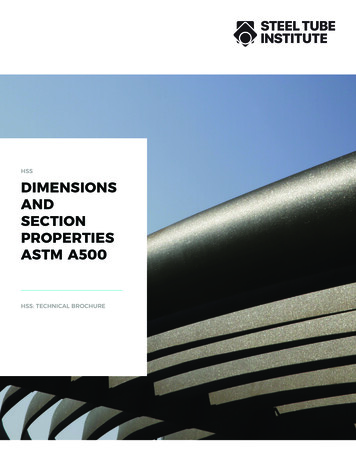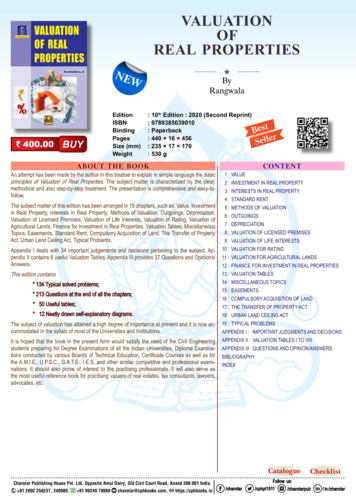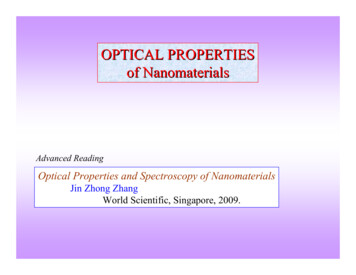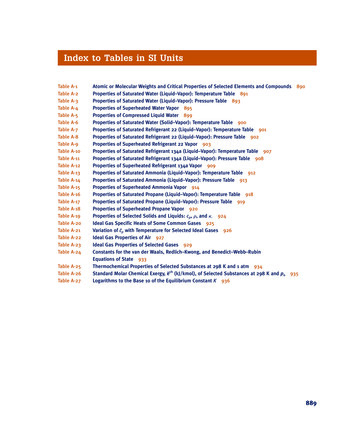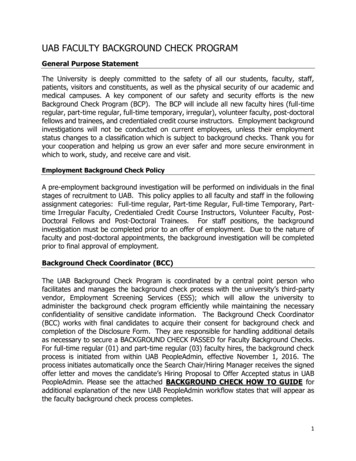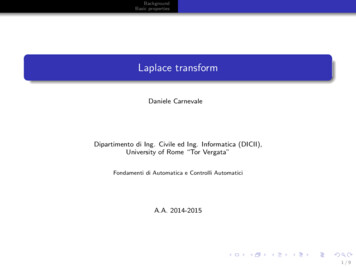
Transcription
BackgroundBasic propertiesLaplace transformDaniele CarnevaleDipartimento di Ing. Civile ed Ing. Informatica (DICII),University of Rome “Tor Vergata”Fondamenti di Automatica e Controlli AutomaticiA.A. 2014-20151/9
BackgroundBasic propertiesThe partial fraction expansionRational functionsConsider a rational functions, i.e. the ratio of polynomials on s C asP (s) bm sm bm 1 sm 1 . . . b1 s b0,sn an 1 sn 1 . . . a1 s a0(1)where coefficients ai and bi are reals. The rational function P (s) is said to beproper if m nstrictly-proper if m nnon-proper if m n (P 1 (s) is strictly-proper).The difference n m is called the relative degree of P (s).The so called zero-poles equivalent representation of P (s) in (1) isP (s) µpΠρi 1 (s zi )mi,Πνi 1 (s pi )ni(2)where µp R, zi is the i-th zero of P (s) (roots of order mi of the denominator),pi isPρthe i-thPν pole of P (s) (roots of order ni of the numerator) such that i 1 mi mand i 1 ni n.2/9
BackgroundBasic propertiesThe partial fraction expansionResidualsLet P (s) be proper (m n), then it can be rewritten asP (s) c0 niν XXi 1 j 1ci,j,(s pi )j(3)whereci,j1lim,(ni j)! s pi dni jni((s pi ) P (s)) .d, sni j(4)If ni 1, i.e. the pole pi is simple, than eq. (4) simplifies down toci,j lim ((s pi )ni P (s))s pi(5)Note that c0 6 0 iif n m.3/9
BackgroundBasic propertiesFoundamental propertiesDefinitionLaplace transform (unilateral)Let f (·) : R 0 R or f (·) : R 0 C such thatZ f (t)e0 stZTdt limT 0 f (t)e st dt , L{f (t)}(s) F (s)(6)is finite for some s C, then f (t) is Laplace transformable.F (s) is a complex variable function. The Laplace transform is a linear operator(integral).If f (t) is Laplace transformable, than it is possible to define the real number β R,that might even be infinite, such that β min{Re(s)} such that the improper integralin (6) converges.Note that if f (t) is transformable with s s1 , then it is transformable for all s s2such that Re(s2 ) Re(s1 ).4/9
BackgroundBasic propertiesFoundamental propertiesStandard function Laplace transformConsider the unitary impulse function 0 t 2δ0 (t) lim t2 0 02 if t 0t [0, ]t [ , 2 ]otherwise,(7)then ZL{δ0 (t)}(s) 0 δ0 (t)e st dt Z δ0 (t) dt 1,0 (8)for all s C.Consider the unitary Heaviside function (step function) defined as 1if t 0δ 1 (t) 0otherwise,(9)thenZL{δ 1 (t)}(s) 0 δ 1 (t)e st dt Z0 e st 1,s(10)for all s such that Re(s) 0 yielding β 0.5/9
BackgroundBasic propertiesFoundamental propertiesStandard function Laplace transform cont’dConsider the (unilateral) exponential function f (t) eat δ 1 (t), a C, thenL{eat δ 1 (t)}(s) Z 0 δ 1 (t)e (s a)t dt L{δ 1 (t)}(s a) 1,s a(11)for all s such that Re(s a) 0 Re(s) Re(a) β .The Laplace transform of cos(ωt)δ 1 (t) isL{cos(ωt)δ 1 (t)}(s) s,s2 ω 2(12)for all s such that Re(s) 0 yielding β 0.6/9
BackgroundBasic propertiesFoundamental propertiesPropertiesTime derivationLet f (t) be locally absolutely continuous and assume that fa (t) f (t) is Laplacetransformable for some βa R. Then also f (t) is transformable withβ max{0, βa }, F (s) L{f (t)}(s) andL{f (t)}(s) sF (s) f (0 ).(13)Furthermore L h 1Xdh f(s) sh F (s) (t)sh 1 k f (k) (0 ).hdtk 0(14)Time integrationLet f (t) Laplace transformable with certain β, then Z t F (s)Lf (τ ) dτ (s) ,s0(15)with βa max{0, β}.7/9
BackgroundBasic propertiesFoundamental propertiesProperties cont’dTime delayLet f (t) Laplace transformable, F (s) L{f (t)}(s), with certain β, thenL {f (t T )δ 1 (t T )} (s) F (s)e sT ,(16)with same β for any T 0.Translation in sLet f (t) Laplace transformable, F (s) L{f (t)}(s), with certain β, then given aC itholds L f (t)eat (s) F (s a),(17)with βa β Re(a).The above properties allow to derive the important formula k t at1Le(s) .k!(s a)k 1(18)8/9
BackgroundBasic propertiesFoundamental propertiesProperties cont’dConvolutionLet f (t) and g(t) Laplace transformable, with some βf and βg , thenL {f (t) ? g(t)} (s) F (s)G(s),(19)with β max{βf , βg } and wheretZtZf (τ )g(t τ )dτ f (t) ? g(t) ,0f (t τ )g(τ )dτ0Final and intial valueLet f (t) Laplace transformable, F (s) L{f (t)}(s), with certain β, and assume thatlimt f (t) exists and is finite, thenlim f (t) lim sF (s).t s 0 (20)If limt 0 f (t) exists and is finite, thenlim f (t) t 0 lim sF (s).s (21)9/9
Informatica (DICII), University of Rome \Tor Vergata" Fondamenti di Automatica e Controlli Automatici A.A. 2014-2015 1/9. Background Basic properties The partial fraction expansion Rational functions . 0 6 0 iif n m. 3/9. Background Basic properties Foundamental properties De nition Laplace transform (unilateral) Let f() : R 0! R or f() : R .



